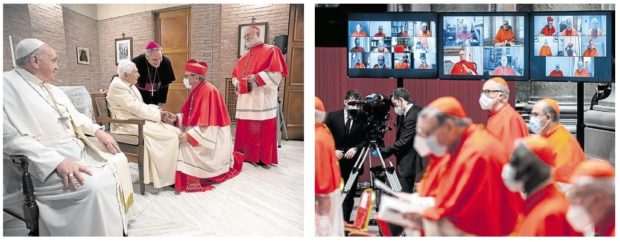Pope names 13 new cardinals, including Filipino archbishop

TWO POPES AND CARDINALS Pope Francis and Pope Emeritus Benedict XVI greet some of the new cardinals following the consistory at the Vatican on Saturday while absent cardinals appear on screens at St. Peter’s Basilica. —REUTERS
VATICAN CITY — Pope Francis created 13 new cardinals on Saturday — including the first African American and Filipino Archbishop Jose Advincula.
Under the soaring dome of St. Peter’s Basilica, the new “princes of the Church” knelt one by one at the feet of the 83-year-old Pontiff, who placed the quadrangular scarlet cap, or biretta, on their heads.
The diverse group—whose members hail from Italy, Malta, the Philippines, Chile, Brunei, Mexico and the United States—reflect not only the changing face of the church of 1.3 billion faithful, but also the Jesuit Pope’s belief in priests focused on the world’s poor.
The 72-year-old archbishop of Washington, Wilton Gregory, told Agence France-Presse (AFP) on Friday he was a “symbolic individual” for being made the first African American cardinal.
Inclusive, transparent
Since Francis’ election in 2013, the Argentine Pope—the first from the Americas—has created 95 new cardinals in ceremonies known as consistories.
Article continues after this advertisementThose named by Francis now make up the majority of cardinals under the age of 80 who will elect his successor. This increases the chances that the Pope’s efforts to make the Roman Catholic Church more inclusive, transparent and more focused on defending the most vulnerable members of society may continue after his death.
Article continues after this advertisementFrancis’ choices reflect not only a desire to promote non-Europeans within the Church, but the Pontiff’s personal fight against social inequality and poverty.
The group of cardinals includes Mexico’s Bishop Emeritus Felipe Arizmendi Esquivel, who has worked among the indigenous population of the poor region of Chiapas, and Archbishop Antoine Kambanda of Rwanda, who lost most of his family in the 1994 genocide.
During the ceremony, Francis warned the new cardinals not to be seduced by their new “eminence” and stray from being “close to the people.”
Restrictions
“The scarlet of a cardinal’s robes, which is the color of blood, can, for a worldly spirit, become the color of a secular ‘eminence,’” said Francis. “When you feel that, you will be off the road.”
Only about 40 current cardinals, all in masks, were in attendance, sitting spaced apart before a limited audience of guests.
Typically, all the world’s cardinals travel to Rome to welcome the newly promoted cardinals during the consistory.
This year, however, many did not attend, and coronavirus restrictions prevented travel for two new cardinals—Cornelius Sim, the Apostolic Vicar of the Muslim-majority nation of Brunei, and Archbishop Advincula of the Philippines.
Advincula said he believed the Pope chose him to acknowledge Catholics living in far-flung areas from Rome.
“I always thought that the Church has to be closer to the people, especially those that are in the peripheries,” Advincula told Vatican News last month after being named.
In a report from the Catholic Bishops’ Conference of the Philippines News, Fr. Emil Arbatin, spokesperson for the Archdiocese of Capiz, said Advincula followed the livestreamed ceremony.
9th Filipino cardinal
Francis assigned to Advincula the title “Cardinal Priest of San Vigilio.”
Advincula, 68, is the ninth Filipino to be named cardinal. Traditionally, cardinals are named from the archbishops of Manila or Cebu.
He and Cardinal Luis Antonio Tagle qualify as cardinal-electors in the next papal election.
Tagle, the former archbishop of Manila, is now Prefect of the Congregation for the Evangelization of Peoples at the Vatican.
Two other living Filipino cardinals—Manila Archbishop Emeritus Gaudencio Rosales, 88, and Cotabato Archbishop Emeritus Orlando Quevedo, 81—are no longer eligible to vote in a conclave.
Their departed predecessors are Rufino Santos and Jaime Sin, who both served as Manila archbishop; Ricardo Vidal and Julio Rosales, who were former Cebu archbishops; and Jose Sanchez, who was a prefect of the Congregation for the Clergy.
Born in Dumalag, Capiz, on March 30, 1952, Advincula is a former bishop of San Carlos in Negros Occidental.
He attended Saint Pius X Seminary in Roxas City and studied theology at the University of Santo Tomas.
—Reports from AFP and Dexter Cabalza